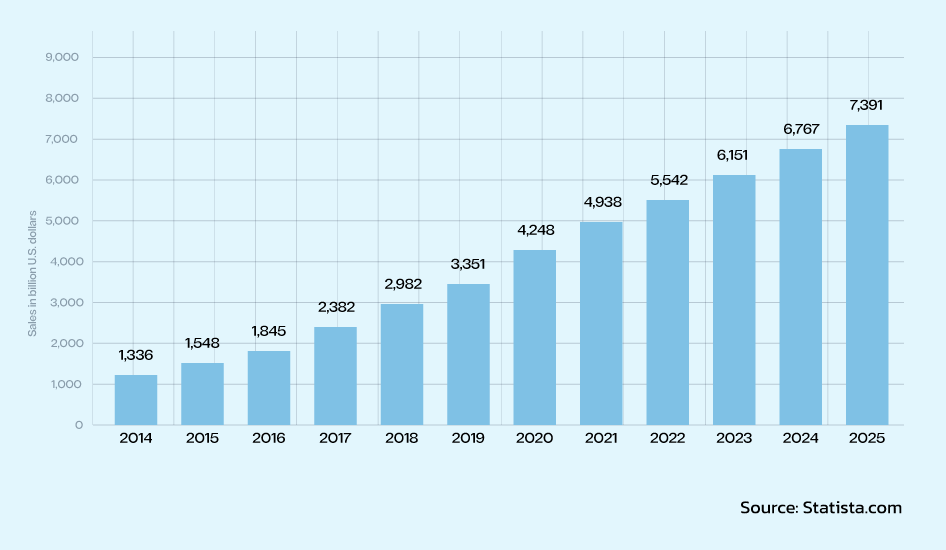

As the title suggests – we are going to talk about eCommerce Sales, starting with stats. Before we talk about SEO for eCommerce, the sales amount will reach 7.39 billion dollars in 2025, as reported by Statista.

So, if you want your business to make more sales through your eCommerce website or business – then this blog is for you as it provides the seven effective ways to boost sales using SEO for eCommerce.
Effective Ways to Boost Your ECommerce Sales With SEO
In this article, we will delve into techniques and approaches for e-commerce marketing with an emphasis on driving organic traffic through SEO optimization.
1. Focus on Reviews and Content
This is the very first point on SEO for eCommerce: solicit feedback from purchasers in the form of testimonials and reviews. Credibility is bolstered, and important keyword-rich material is provided, which may improve search engine results thanks to user-generated content.
You can increase sales and repeat business by providing a streamlined and straightforward checkout process for your consumers.
2. Focus on E.E.A.T.
You might be aware of what E-E.A.T is. It stands for experience, expertise, authority, and trustworthiness—three crucial elements that Google utilizes as part of its ranking factors to assist in identifying spam and reduce the search ranking of suspicious or dangerous websites.
So, talking about SEO for eCommerce implies that displaying your experience, authority, and reliability as an eCommerce website is much more vital today than ever.
One of the most successful methods to achieve this is via content—blog entries, SEO-optimized product pages, and meta titles and descriptions. A well-thought-out website with exciting and relevant material won’t be considered a hoax by your customers—or Google.
3. Make Sure Your Meta Titles and Descriptions are Up to Date
Now, after looking at Keywords, the next step in SEO for eCommerce is to ensure you have written the perfect Meta Titles and Descriptions. The titles for your web pages should not exceed 60 characters, including spaces and punctuation. When displayed in Google search results, the title tag will be shown as you set it.
For visibility on both desktop and mobile search results, keep your descriptions within 160 characters. However, please note that Google sometimes modifies descriptions dynamically based on the searched keyword, so they might end up longer or shorter than what you wrote or completely different.
Ensure that each page’s meta title and description include the keyword when it comes to SEO for eCommerce.
4. Make Proper Use of Long-Tail Keywords
Are you aware that long-tail keywords make up the majority of search queries? Because of this, including long-tail keywords in your approach is essential. If you don’t use long-tail keywords, you may as well ignore opportunities. The uselessness of this is apparent.
Since they are more precise and have less competition, long-tail keywords are also easier to rank for. However, they are quite deliberate in their aims. Conversion rates would surely increase if effort were put into targeting and ranking for specific keywords.
5. Add Structured Data
Google is fantastic at improving people’s search results. When searching, have you ever discovered the solution immediately, without having to click on any links? I mean, it must occur often.
This occurs because the S.E.R.P. has the information you need. This is excellent news for consumers, but it does put pressure on companies to improve the visibility of their content in search engines. People may not always follow your links.
Data markup may help your content stand out in search engine optimization for e-commerce and highlight information that customers are more likely to click on. It may not affect search engine results, but it does raise brand awareness. Boosts the possibility that guests will visit. Markup for products and user reviews is a must-have for every online shop. Location markup might be helpful for traditional retailers.
6. Improve Page Load Time
Your online shop’s website is no different from any other: its loading time is paramount. Customers won’t buy from you if they wait too long for your site to load.
Even search giant Google factors page load time into their desktop search results. If your site is sluggish to load, you should use a tool like Google Pagespeed Insights to analyze its performance and adjust depending on the results.
7. Use Google Trends to Supplement Your Keyword Research
Why not make use of Google’s tools to improve your site’s position in Google’s search results?
Google Trends is one instrument that might be useful. Google Patterns lets you look into the patterns related to terms, something that even the greatest keyword research tools may have trouble doing. This can help you improve your keyword research by identifying phrases that SEO tools may miss or not sufficiently monitor.
8. Use Google Trends to Supplement Your Keyword Research
Start by researching keywords your potential buyers use. These are the exact terms they type into Google when ready to purchase. Local businesses in Seattle might combine product names with location keywords to attract nearby customers, but broader, product-focused keywords remain essential for scaling beyond any single city.
For example, a Seattle-based store selling handmade candles could optimize product pages for “handmade candles Seattle” to attract local buyers, while also targeting “soy candles” or “scented candles online” to reach customers across the country. This combination brings in nearby shoppers ready to visit or buy locally, plus a wider audience shopping online.
Wrap Up
NFlow Tech is a recognized company in the digital commerce industry, providing services for eCommerce and digital marketing solutions. Additionally, we offer various marketing services, including SEO for eCommerce, SMO., content marketing, PPC advertising and more.
Our team of professionals utilizes technologies to deliver tailored solutions that enhance your business’s profitability.
If you have any business-related inquiries, please feel free to contact us.

Nevil Bhatt
Nevil is the owner of one of the fastest-growing digital marketing agency in India. Having a great knowledge of the IT field and business management, he decided to bring a revolution in the digital world by providing valuable and customised solutions across the globe. Whether it's real or digital, he knows how to handle sustainable relationships and meaningful interactions.



